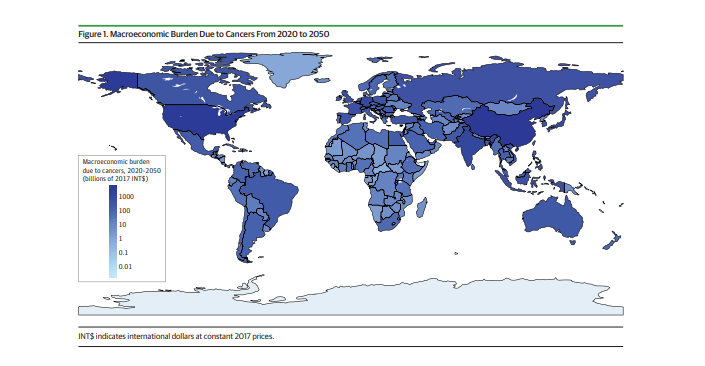the health strategist
research institute for continuous transformation — in health & tech
Joaquim Cardoso MSc
Chief Researcher & Editor
March 20, 2023
Key Points
Question
- What is the estimated economic cost and cost distribution of 29 cancers in 204 countries and territories from 2020 to 2050?
Findings
- In this decision analytical modeling study, the global economic cost of cancers from 2020 to 2050 was estimated to be $25.2 trillion (in international dollars at constant 2017 prices).
- The economic burden and the health burden were distributed unequally across countries, world regions, and country income groups.
Meaning
- Results of this study suggest that global efforts to contain projected increases in the burden of cancers are warranted.
DEEP DIVE

Estimates and Projections of the Global Economic Cost of 29 Cancers in 204 Countries and Territories From 2020 to 2050
JAMA Oncology
Simiao Chen, ScD1,2; Zhong Cao, BE3,4; Klaus Prettner, PhD5,6; Michael Kuhn, PhD5,7; Juntao Yang, PhD8; Lirui Jiao, BA9; Zhuoran Wang, BSc2; Weimin Li, MD10,11; Pascal Geldsetzer, MD, ScD12; Till Bärnighausen, MD, ScD1,2,13; David E. Bloom, PhD13; Chen Wang, MD, PhD2,14,15
February 23, 2023
Abstract
Importance
- Cancers are a leading cause of mortality, accounting for nearly 10 million annual deaths worldwide, or 1 in 6 deaths.
- Cancers also negatively affect countries’ economic growth.
- However, the global economic cost of cancers and its worldwide distribution have yet to be studied.
Objective
- To estimate and project the economic cost of 29 cancers in 204 countries and territories.
Design, Setting, and Participants
- A decision analytical model that incorporates economic feedback in assessing health outcomes associated with the labor force and investment.
- A macroeconomic model was used to account for (1) the association of cancer-related mortality and morbidity with labor supply; (2) age-sex-specific differences in education, experience, and labor market participation of those who are affected by cancers; and (3) the diversion of cancer treatment expenses from savings and investments.
- Data were collected on April 25, 2022.
Main Outcomes and Measures
- Economic cost of 29 cancers across countries and territories.
- Costs are presented in international dollars at constant 2017 prices.
Results
- The estimated global economic cost of cancers from 2020 to 2050 is $25.2 trillion in international dollars (at constant 2017 prices), equivalent to an annual tax of 0.55% on global gross domestic product.
- The 5 cancers with the highest economic costs are tracheal, bronchus, and lung cancer (15.4%); colon and rectum cancer (10.9%); breast cancer (7.7%); liver cancer (6.5%); and leukemia (6.3%).
- China and the US face the largest economic costs of cancers in absolute terms, accounting for 24.1% and 20.8% of the total global burden, respectively.
- Although 75.1% of cancer deaths occur in low- and middle-income countries, their share of the economic cost of cancers is lower at 49.5%.
- The relative contribution of treatment costs to the total economic cost of cancers is greater in high-income countries than in low-income countries.
Conclusions and Relevance
- In this decision analytical modeling study, the macroeconomic cost of cancers was found to be substantial and distributed heterogeneously across cancer types, countries, and world regions.
- The findings suggest that global efforts to curb the ongoing burden of cancers are warranted.












